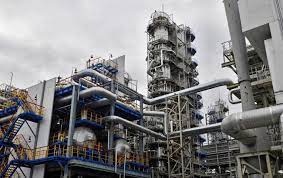
Russia’s oil refining has dropped only 3% this year despite Ukraine’s largest drone campaign to date, industry sources and data show. Refineries managed to offset damage from attacks by using spare units and repairing struck facilities, preventing a sharper decline in fuel production.
Ukraine has intensified long-range drone strikes deep inside Russian territory, targeting refineries, depots, and pipelines to disrupt Moscow’s major war revenue streams. Most attacks occurred early in 2025 and resumed from August, striking at least 17 major refineries and forcing Russia to curb fuel exports while strengthening drone defenses.
During the peak of the second wave, between August and October, attacks and planned maintenance temporarily removed about 20% of Russia’s refining capacity, according to calculations based on three anonymous Russian industry sources. Despite this, overall refining volumes fell only 6% to roughly 5.1 million barrels per day, compared with the same period last year. From January to October, total oil processing reached approximately 220 million metric tons (5.2 million bpd), down 3% from 2024.
Sources said Russian refineries, which had been operating below full capacity before the attacks, mitigated losses by restarting spare units at both damaged and unaffected plants and quickly repairing struck facilities. Russia’s total refining capacity is around 6.6 million bpd but is rarely fully utilised, giving operators flexibility in emergencies.
Kyiv views its drone offensive as a way to limit fuel supplies to Russian troops and cut Moscow’s oil revenues. The International Energy Agency reported that Russian revenue from crude oil and product sales fell in August to one of the lowest levels since the war began in 2022. President Volodymyr Zelenskiy claimed that long-range strikes may have cut gasoline availability in Russia by up to 20%.
The Kremlin insists the domestic fuel market remains stable. President Vladimir Putin has vowed that Moscow will not bow to external pressure.
While Russian refineries have adapted, the drone attacks have had tangible impacts. In the first quarter of 2025, Ukraine struck six major facilities, including Ryazan, Volgograd, Saratov, Tuapse, Ufa, and Astrakhan. Since August, at least 58 additional attacks have targeted Russian energy sites, reaching as far as 2,000 km (1,200 miles) into Russian territory, according to UK-based Open Source Centre data. Refineries damaged include Novokuibyshevsk, Kirishi, and Salavat.
Western sanctions complicate Russia’s efforts to source spare parts, many of which were originally supplied by Western firms that upgraded Russian refineries over the past 30 years. Russian companies have reportedly developed domestic solutions or imported replacements from China, a key strategic ally. Industry sources noted that repairs often return distillation units to service within weeks, though costs are high and longer downtimes are possible if drone attacks persist.
Analysts say the resilience of Russia’s refining sector highlights the country’s ability to leverage spare capacity and rapid repairs, but ongoing attacks could challenge its ability to sustain production over the long term.
Erizia Rubyjeana



